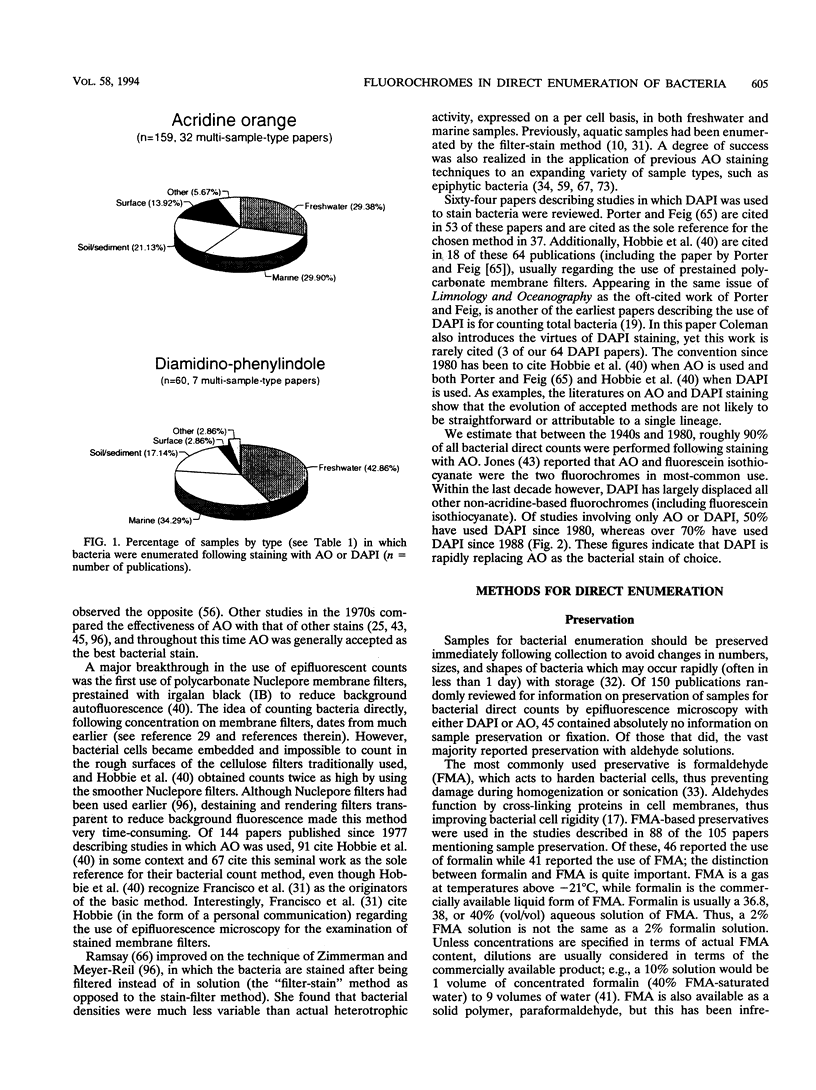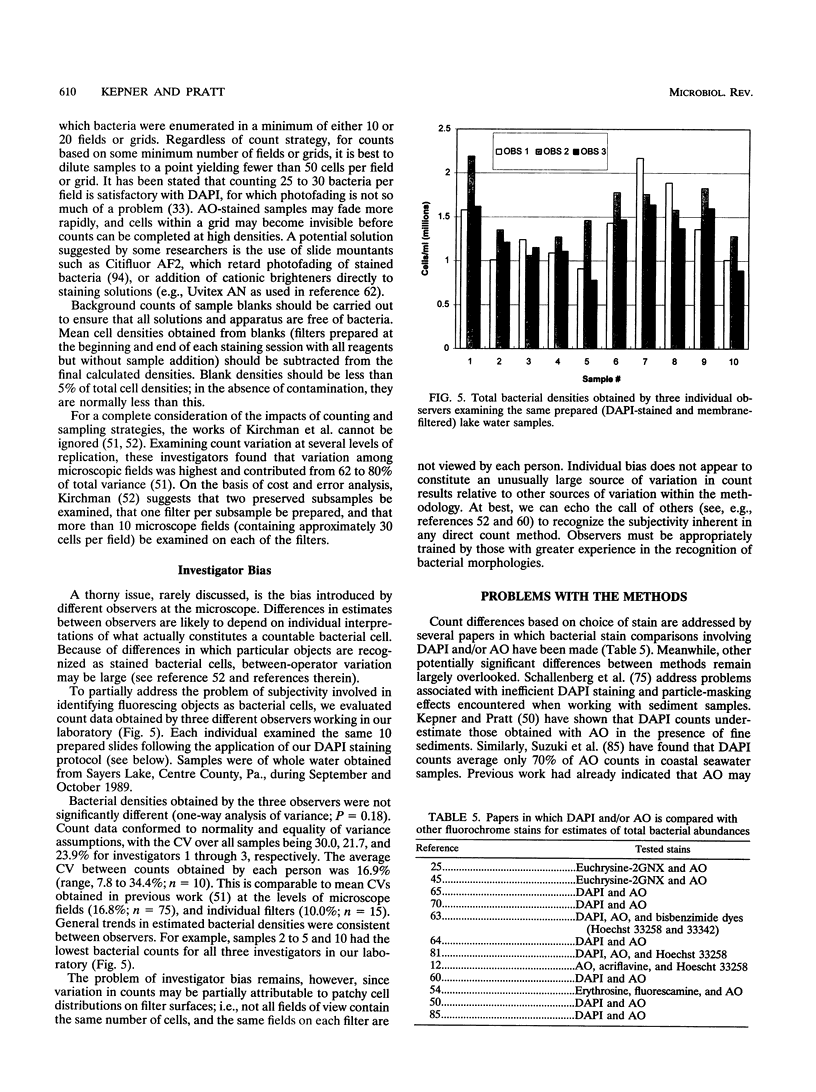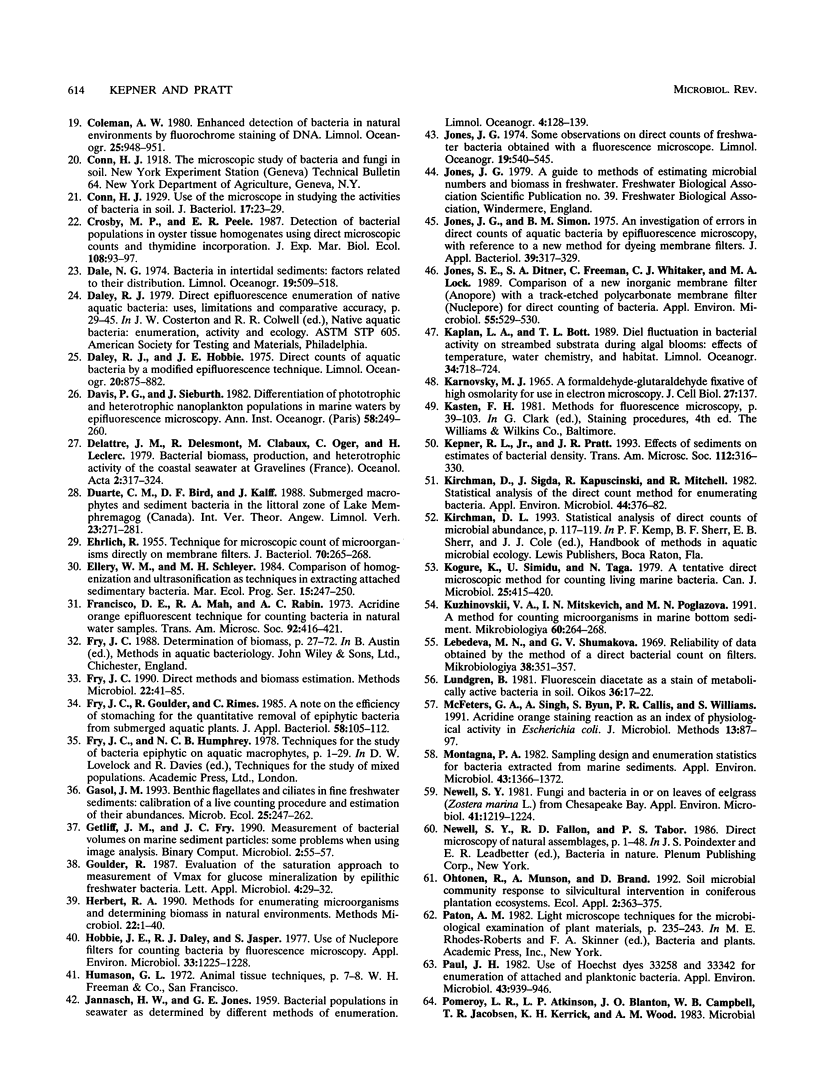Abstract
Understanding the role of bacteria in microbial food webs is intimately connected to the methods applied in the direct enumeration of bacteria. We have examined over 220 papers describing studies in which fluorochrome staining followed by epifluorescent microscopic direct counts was used to estimate total bacterial abundances. In this review, we summarize patterns in the use of 3,6-bis[dimethylamino]acridinium chloride (acridine orange) and 4',6-diamidino-2-phenylindole (DAPI), the two stains most frequently used in bacterial enumeration. The staining of samples with these fluorochromes, followed by filtration and direct counting of bacterial cells on filter surfaces, has become routine over the past 10 years. We examine trends in features of the standard direct count methods, such as sample preservation and preparation techniques, membrane filter types used, applied stain concentrations, duration of staining, and counting strategies, in relation to the types of samples being examined. The high variability in bacterial counts observed within similar sample types may be partially accounted for by differences in methods. Synthesizing review findings, we include a recommended method for the direct enumeration of bacteria in environmental samples.
Full text
PDF












Selected References
These references are in PubMed. This may not be the complete list of references from this article.
- Allan R. A., Miller J. J. Influence of S-adenosylmethionine on DAPI-induced fluorescence of polyphosphate in the yeast vacuole. Can J Microbiol. 1980 Aug;26(8):912–920. doi: 10.1139/m80-158. [DOI] [PubMed] [Google Scholar]
- Babiuk L. A., Paul E. A. The use of fluorescein isothiocyanate in the determination of the bacterial biomass of grassland soil. Can J Microbiol. 1970 Feb;16(2):57–62. doi: 10.1139/m70-011. [DOI] [PubMed] [Google Scholar]
- Back J. P., Kroll R. G. The differential fluorescence of bacteria stained with acridine orange and the effects of heat. J Appl Bacteriol. 1991 Jul;71(1):51–58. [PubMed] [Google Scholar]
- Bae H. C., Cota-Robles E. H., Casida L. E. Microflora of soil as viewed by transmission electron microscopy. Appl Microbiol. 1972 Mar;23(3):637–648. doi: 10.1128/am.23.3.637-648.1972. [DOI] [PMC free article] [PubMed] [Google Scholar]
- Bakken L. R. Separation and purification of bacteria from soil. Appl Environ Microbiol. 1985 Jun;49(6):1482–1487. doi: 10.1128/aem.49.6.1482-1487.1985. [DOI] [PMC free article] [PubMed] [Google Scholar]
- Bergström I., Heinänen A., Salonen K. Comparison of acridine orange, acriflavine, and bisbenzimide stains for enumeration of bacteria in clear and humic waters. Appl Environ Microbiol. 1986 Mar;51(3):664–667. doi: 10.1128/aem.51.3.664-667.1986. [DOI] [PMC free article] [PubMed] [Google Scholar]
- Bloem J., Bär-Gilissen M. J., Cappenberg T. E. Fixation, counting, and manipulation of heterotrophic nanoflagellates. Appl Environ Microbiol. 1986 Dec;52(6):1266–1272. doi: 10.1128/aem.52.6.1266-1272.1986. [DOI] [PMC free article] [PubMed] [Google Scholar]
- Bowden W. B. Comparison of two direct-count techniques for enumerating aquatic bacteria. Appl Environ Microbiol. 1977 May;33(5):1229–1232. doi: 10.1128/aem.33.5.1229-1232.1977. [DOI] [PMC free article] [PubMed] [Google Scholar]
- Caron D. A. Technique for enumeration of heterotrophic and phototrophic nanoplankton, using epifluorescence microscopy, and comparison with other procedures. Appl Environ Microbiol. 1983 Aug;46(2):491–498. doi: 10.1128/aem.46.2.491-498.1983. [DOI] [PMC free article] [PubMed] [Google Scholar]
- Clarke K. R., Joint I. R. Methodology for estimating numbers of free-living and attached bacteria in estuarine water. Appl Environ Microbiol. 1986 May;51(5):1110–1120. doi: 10.1128/aem.51.5.1110-1120.1986. [DOI] [PMC free article] [PubMed] [Google Scholar]
- EHRLICH R. Technique for microscopic count of microorganisms directly on membrane filters. J Bacteriol. 1955 Sep;70(3):265–268. doi: 10.1128/jb.70.3.265-268.1955. [DOI] [PMC free article] [PubMed] [Google Scholar]
- Francisco D. E., Mah R. A., Rabin A. C. Acridine orange-epifluorescence technique for counting bacteria in natural waters. Trans Am Microsc Soc. 1973 Jul;92(3):416–421. [PubMed] [Google Scholar]
- Hobbie J. E., Daley R. J., Jasper S. Use of nuclepore filters for counting bacteria by fluorescence microscopy. Appl Environ Microbiol. 1977 May;33(5):1225–1228. doi: 10.1128/aem.33.5.1225-1228.1977. [DOI] [PMC free article] [PubMed] [Google Scholar]
- Jones J. G., Simon B. M. An investigation of errors in direct counts of aquatic bacteria by epifluorescence microscopy, with reference to a new method for dyeing membrane filters. J Appl Bacteriol. 1975 Dec;39(3):317–329. doi: 10.1111/j.1365-2672.1975.tb00578.x. [DOI] [PubMed] [Google Scholar]
- Jones S. E., Ditner S. A., Freeman C., Whitaker C. J., Lock M. A. Comparison of a new inorganic membrane filter (Anopore) with a track-etched polycarbonate membrane filter (Nuclepore) for direct counting of bacteria. Appl Environ Microbiol. 1989 Feb;55(2):529–530. doi: 10.1128/aem.55.2.529-530.1989. [DOI] [PMC free article] [PubMed] [Google Scholar]
- Kirchman D., Sigda J., Kapuscinski R., Mitchell R. Statistical analysis of the direct count method for enumerating bacteria. Appl Environ Microbiol. 1982 Aug;44(2):376–382. doi: 10.1128/aem.44.2.376-382.1982. [DOI] [PMC free article] [PubMed] [Google Scholar]
- Kogure K., Simidu U., Taga N. A tentative direct microscopic method for counting living marine bacteria. Can J Microbiol. 1979 Mar;25(3):415–420. doi: 10.1139/m79-063. [DOI] [PubMed] [Google Scholar]
- Lebedeva M. N., Shumakova G. V. K voprosu o dostovernosti dannykh, poluchennykh metodom priamogo ucheta bakterii na fil'trakh. Mikrobiologiia. 1969 Mar-Apr;38(2):351–357. [PubMed] [Google Scholar]
- McFeters G. A., Singh A., Byun S., Callis P. R., Williams S. Acridine orange staining reaction as an index of physiological activity in Escherichia coli. J Microbiol Methods. 1991;13:87–97. doi: 10.1016/0167-7012(91)90009-f. [DOI] [PubMed] [Google Scholar]
- Montagna P. A. Sampling design and enumeration statistics for bacteria extracted from marine sediments. Appl Environ Microbiol. 1982 Jun;43(6):1366–1372. doi: 10.1128/aem.43.6.1366-1372.1982. [DOI] [PMC free article] [PubMed] [Google Scholar]
- Newell S. Y. Fungi and Bacteria in or on Leaves of Eelgrass (Zostera marina L.) from Chesapeake Bay. Appl Environ Microbiol. 1981 May;41(5):1219–1224. doi: 10.1128/aem.41.5.1219-1224.1981. [DOI] [PMC free article] [PubMed] [Google Scholar]
- Paul J. H. Use of hoechst dyes 33258 and 33342 for enumeration of attached and planktonic bacteria. Appl Environ Microbiol. 1982 Apr;43(4):939–944. doi: 10.1128/aem.43.4.939-944.1982. [DOI] [PMC free article] [PubMed] [Google Scholar]
- Rigler R., Jr Microfluorometric characterization of intracellular nucleic acids and nucleoproteins by acridine orange. Acta Physiol Scand Suppl. 1966;267:1–122. [PubMed] [Google Scholar]
- Roszak D. B., Colwell R. R. Survival strategies of bacteria in the natural environment. Microbiol Rev. 1987 Sep;51(3):365–379. doi: 10.1128/mr.51.3.365-379.1987. [DOI] [PMC free article] [PubMed] [Google Scholar]
- Schallenberg M., Kalff J., Rasmussen J. B. Solutions to problems in enumerating sediment bacteria by direct counts. Appl Environ Microbiol. 1989 May;55(5):1214–1219. doi: 10.1128/aem.55.5.1214-1219.1989. [DOI] [PMC free article] [PubMed] [Google Scholar]
- Shigenaka Y., Watanabe K., Kaneda M. Effects of glutaraldehyde and osmium tetroxide on hypotrichous ciliates, and determination of the most satisfactory fixation methods for electron microscopy. J Protozool. 1973 Aug;20(3):414–420. doi: 10.1111/j.1550-7408.1973.tb00912.x. [DOI] [PubMed] [Google Scholar]
- Sieracki M. E., Johnson P. W., Sieburth J. M. Detection, enumeration, and sizing of planktonic bacteria by image-analyzed epifluorescence microscopy. Appl Environ Microbiol. 1985 Apr;49(4):799–810. doi: 10.1128/aem.49.4.799-810.1985. [DOI] [PMC free article] [PubMed] [Google Scholar]
- Torrella F., Morita R. Y. Microcultural study of bacterial size changes and microcolony and ultramicrocolony formation by heterotrophic bacteria in seawater. Appl Environ Microbiol. 1981 Feb;41(2):518–527. doi: 10.1128/aem.41.2.518-527.1981. [DOI] [PMC free article] [PubMed] [Google Scholar]
- Yoon W. B., Rosson R. A. Improved method of enumeration of attached bacteria for study of fluctuation in the abundance of attached and free-living bacteria in response to diel variation in seawater turbidity. Appl Environ Microbiol. 1990 Mar;56(3):595–600. doi: 10.1128/aem.56.3.595-600.1990. [DOI] [PMC free article] [PubMed] [Google Scholar]


